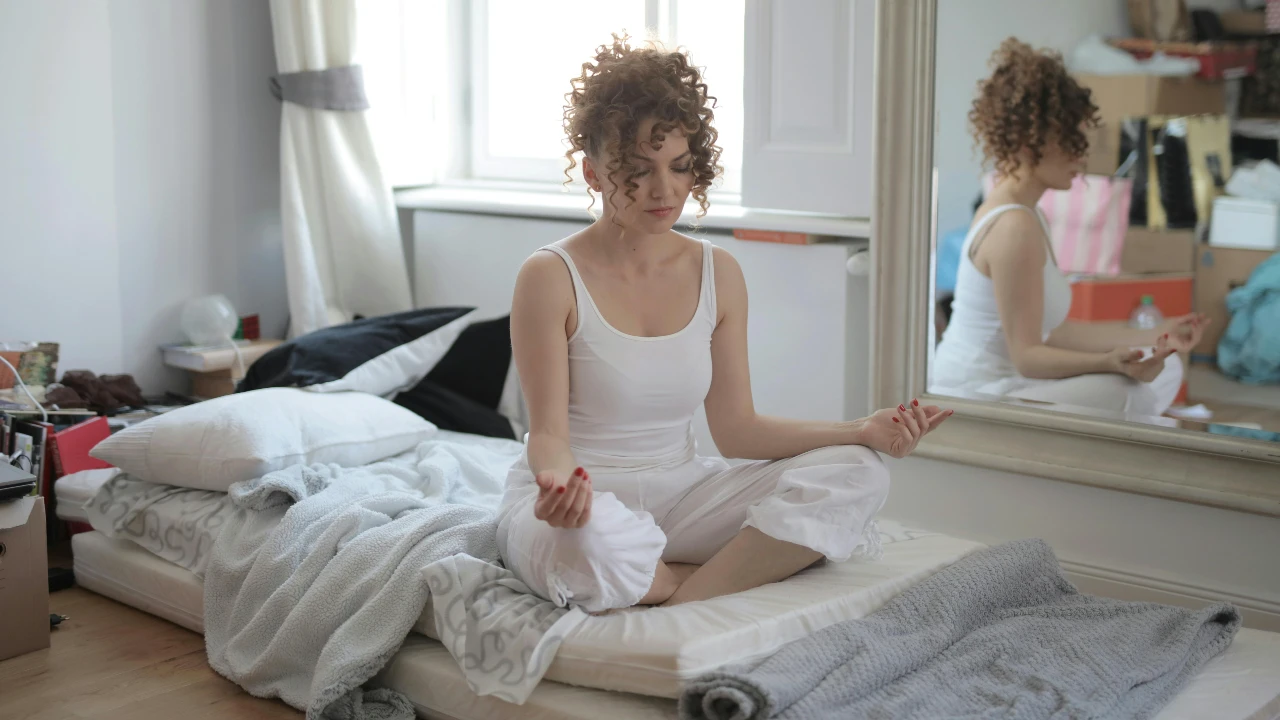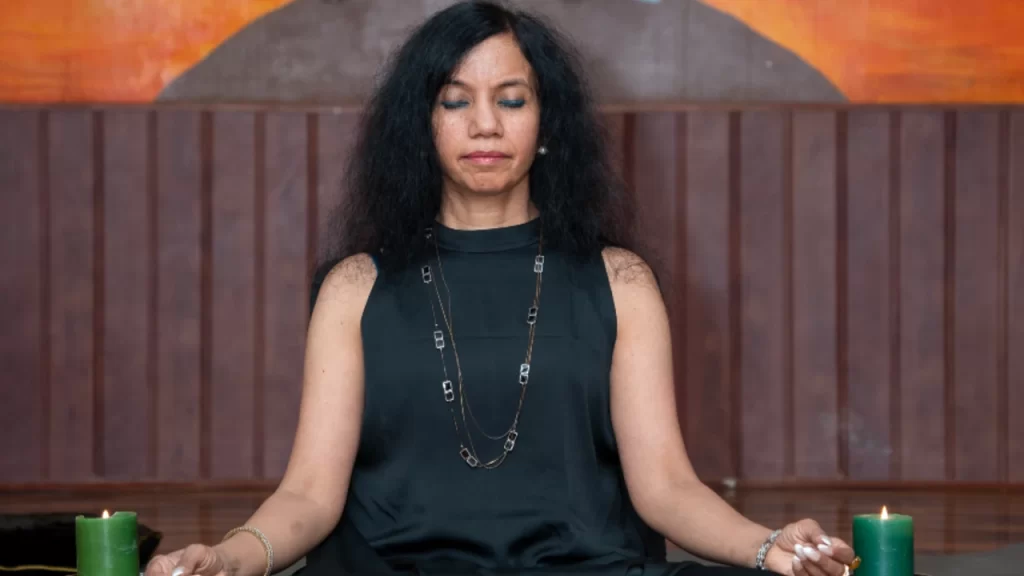Bedtime meditation can be a means of relaxation, reducing anxious thoughts, and preparing your body for a good sleep. For those who begin with meditation, knowing how to meditate in bed for beginners is a very practical manner of learning mindfulness and some relaxation techniques without elaborate setup procedures. In this guide, we will walk you through why bedtime meditation can work for you, step by step, and answer all your common questions.
Why Meditate in Bed?
Developing meditation in bed can be the best practice of sleep premeditation with many advantages, especially for those individuals who have problems with anxiety and having insomnia nights. Learning how to meditate in bed for beginners is the most effective method because most people associate a quiet mind with good quality sleep. This practice is for those who can fall asleep with minimal effort and be asleep when they wake in the middle of the night. NIH studies have shown that the meditating brain increases its activity levels of alpha and theta brain waves, characteristic patterns that indicate deep relaxation and the light stages of sleep.
Promotes Better Sleep: Meditation encourages the production of melatonin, a hormone essential for regulating sleep cycles.
Eases Anxiety: This would relieve anxiety because sleep anxiety meditation would reduce racing thoughts, which are common and often prevent people from sleeping.
Reduces Muscle Tension and Stress:It decreases muscle tension and stress since meditation is characterized by the total relaxation of the body as well as the mind.
Preparing for Bedtime Meditation
You would want to set the atmosphere right before you begin your meditation. Bedtime meditation should be restful and nurturing and set you up for sleep.
Dim the lights: Low lighting sends a signal to your body that it’s time to wind down.
Remove Distractions: Remove All Distractions Switch off your telephone or enable Do Not Disturb to remain uninterrupted.
Set Your Position: Position Yourself Lie on your back or your side.
Step-by-Step Guide on How to Meditate in Bed for Beginners
Step 1: Focused Breathing
Start with deep focused breathing-in an important part of any beginner how to meditate in bed for beginners or anxiety sleep meditation guide. Slowly breathe into your nose deeply and exhale out of the mouth. You should begin to feel your chest lifting and dropping with each deep breath. This type of deep focused breathing may help a person calm down their own heart rate as well as get their body to know when it’s time to really relax.
Step 2: Body Scan
This practice involves a gentle relaxation technique, where you direct your attention to different parts of your body, from head to toe, as part of how to meditate in bed for beginners. This method helps release any muscular tension that has accumulated throughout the day. By consciously relaxing these areas, you may relieve discomfort or pain, often caused by stiffness, as you guide tension away with each sigh.
Techniques for Meditation in Bed
Guided Meditation
Guided meditation uses audio or video tracks to walk you through the meditation process. Usually, it has soft background music and gentle guiding. These are found in apps like Calm or Insight Timer, offering wide sessions specifically for anxiety sleep meditation.
Mindfulness Meditation
Mindfulness meditation asks you to be neutral about your thoughts, feelings, and sensations. You do not have to make the thoughts quiet. Accept the thoughts and let them pass. Mindfulness practice might even cause you to sleep by relaxing while paying attention to your body and breath more closely.
Mantra Repetition
Mantras are just simple words or phrases that are repeated to help in concentration and relaxation. One can use a word that represents calmness, such as “peace” or “relax.” Repeating it quietly in your mind can help focus your attention and keep intrusive thoughts at bay.
Bedtime Meditation Techniques Tips
This should become a habit. As you meditate more frequently, the easier it will be to fall asleep.
Add healing practices: You add alchemy energy healing to balance the emotional energy and reduce anxiety using meditation combined with energy healing.
Supportive objects: Some healing stones therapy, like amethyst or rose quartz, contribute to feelings of peacefulness and relaxation.
Consider Life Counseling: You may seek the services of a life coach here in India or even a mental health counselor to give you even better tools of handling stress and anxiety and complement your meditation practice.
How Meditation Enhances Quality of Sleep and Alleviates Anxiety
Regulation of cortisol levels is permitted while stimulating the production of melatonin, making it much easier to fall asleep without external assistance. Practicing how to meditate in bed for beginners can be particularly beneficial, as frequent meditators often experience higher levels of alpha and theta brainwave activities associated with relaxation and light sleep conditions.
Incorporating how to meditate in bed for beginners can also be useful for those introducing anxiety sleep meditation practices to manage generalized anxiety disorder (GAD). The American Psychological Association notes that meditation can reduce anxiety among GAD patients by as much as 30%.
Common Errors Beginners Make in Sleep Meditation
Continuous Meditating: One should not take any drug in their bed for the entire day and then face an inability to sleep.
Forcing Relaxation: Your practice should be effortless. If you become awkwardly tense, move your position or your technique.
Thinking Too Much About the Process: Do not get too caught up on “getting it right”; rather focus on the practice itself.
Creating a Bed Time Meditation Routine
A habit creates the right practice. Here are some suggestions that may help make a routine a habit.
Set a Bedtime Reminder:Create a bedtime reminder on your phone that softly reminds you to begin with the meditation routine.
Add Gentle Stretching: Stretching before meditation can release the physical tension that has accrued during the day.
Intention for Sleep: Mentally intend to relax deeply and let go of the day, preparing your body for sleep.
Other Resources for Bed Meditation
As a beginner, there are many resources to help you through your bedtime meditation. Here are some:
Headspace: These are great meditations for beginners.
Aura: Sleep-focused relaxing routines.
Life Counseling and Therapy: Talking life counseling to a counselor or coach, like a life coach India and family constellation, may be able to offer you more tailored guidance on how to work through your stress and anxiety.
Conclusion on Bedtime Meditation for Beginners
Bedtime meditation can be a game-changer for anybody dealing with stress, anxiety, or insomnia. It is not complex to learn how to meditate in bed for beginners. it is all about relaxation and breathing. Regular practice helps you manage daily stress and sets the stage for a peaceful, restorative night’s sleep.
FAQs
How to meditate when in bed?
Start by finding a comfortable position on your bed, whether it’s lying down or sitting up with support. Take a few moments to stretch and release any tension in your muscles. Settle into a relaxed posture, close your eyes, and take a few deep breaths to center yourself
Is it good to meditate on your bed?
There may be several possible benefits to meditating in bed, including: Comfort: Meditating in bed helps people feel comfortable and relaxed in a familiar environment. Relaxing space: Many people associate their bed with rest and relaxation.
Is it OK to meditate to sleep?
You can try it for just a few minutes, or do it for an hour. However, research does show that meditating for between 10 and 30 minutes may be more effective for helping sleep. Meditation is all about letting go of judgment. Thoughts may come into your head as you try to relax.







Leave a Reply